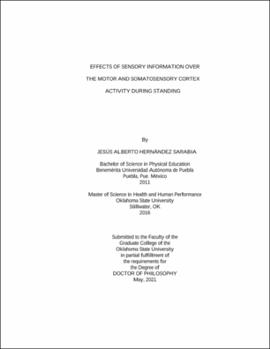| dc.contributor.advisor | DeFreitas, Jason M. | |
| dc.contributor.author | Hernandez Sarabia, Jesus Alberto | |
| dc.date.accessioned | 2021-09-24T13:33:03Z | |
| dc.date.available | 2021-09-24T13:33:03Z | |
| dc.date.issued | 2021-05 | |
| dc.identifier.uri | https://hdl.handle.net/11244/330878 | |
| dc.description.abstract | The purpose of this study was to identify changes in cortical hemodynamics of motor and somatosensory cortex related to balancing tasks during inhibition of muscle spindles and cutaneous receptors of the dominant leg. Data were obtained from twelve participants (age: 24.8 +/- 4.59 years). The study consisted of four randomized order visits to identify cortical hemodynamic changes while standing under normal conditions (Ctrl), with muscle spindles inhibited (MSI), with cutaneous receptors inhibited (CB), and with the muscle spindles and cutaneous receptors inhibited (BOTH). Muscle spindles were inhibited by applying five minutes of vibration over the soleus muscle; pre- and post-vibration (MSI and BOTH) H-reflex amplitude was measured for later statistical analysis. Lidocaine was applied and left over the foot sole for 30 minutes; sensitivity threshold and two-point discrimination variables were obtained under normal conditions (Ctrl) and anesthetic effect (CB and BOTH). Cortical hemodynamics were measured using an fNIRS placed over each participant's head while performing two counterbalanced blocks of bipedal and unipedal standing with the eyes closed. During MSI and BOTH five minutes of vibration were applied before each block of standing tasks. Statistical analysis consisted of performing different repeated measures ANOVA; then, if needed, post-hoc test consisted of several paired samples t-test (corrected for multiple comparisons). Findings revealed that, compared to pre-, H-reflex amplitude was significantly lower after vibration. Lidocaine findings were inconclusive with a higher sensitivity threshold on the heel during BOTH than Ctrl, but two-point discrimination did not show any significant effect among the visits. Body sway was not different among visits but increased from bipedal to unipedal standing. Cortical hemodynamics revealed that mean oxyhemoglobin activity was not different during bipedal standing among the visits, but it was different during visits that inhibited muscle spindles compared to visits that did not inhibit muscle spindles. In conclusion, muscle spindle inhibition of the soleus muscle can alter the motor and somatosensory cortex's cortical hemodynamics during unipedal standing, but these changes did not influence balance performance. Cutaneous block might not be achieved by applying lidocaine over the foot sole for 30 minutes; therefore, conclusions regarding the cutaneous receptors' influence were not possible. | |
| dc.format | application/pdf | |
| dc.language | en_US | |
| dc.rights | Copyright is held by the author who has granted the Oklahoma State University Library the non-exclusive right to share this material in its institutional repository. Contact Digital Library Services at lib-dls@okstate.edu or 405-744-9161 for the permission policy on the use, reproduction or distribution of this material. | |
| dc.title | Effects of sensory information over the motor and somatosensory cortex activity during standing | |
| dc.contributor.committeeMember | Dawes, Jay | |
| dc.contributor.committeeMember | Trevino, Michael | |
| dc.contributor.committeeMember | Grindstaff, Jennifer | |
| osu.filename | HernandezSarabia_okstate_0664D_17198.pdf | |
| osu.accesstype | Open Access | |
| dc.type.genre | Dissertation | |
| dc.type.material | Text | |
| dc.subject.keywords | balance | |
| dc.subject.keywords | cutaneous receptors | |
| dc.subject.keywords | fnirs | |
| dc.subject.keywords | muscle spindles | |
| dc.subject.keywords | proprioception | |
| dc.subject.keywords | vibration | |
| thesis.degree.discipline | Health, Leisure and Human Performance | |
| thesis.degree.grantor | Oklahoma State University | |
